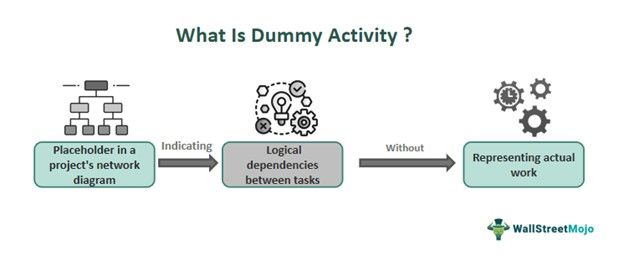Table Of Contents
What Is Dummy Activity?
Dummy Activity in project management refers to a placeholder task used to represent a dependency between two activities in a project network diagram. Its purpose is to ensure that the sequence of activities is logically sound and that dependencies are maintained correctly, even if there's no direct relationship between the tasks other than their order of occurrence.

Dummy events aid in comprehending project dependencies. Understanding their propagation helps stakeholders grasp how alterations may adversely affect the organization. They serve as critical tools for stakeholders to foresee and mitigate potential negative impacts resulting from changes within the project timeline.
Key Takeaways
- A dummy activity definition refers to a task used to represent a dependency between two real tasks in a network diagram without requiring any actual work.
- It accurately represents task dependencies in project management without consuming resources or time, ensuring the logical sequencing of activities in a project schedule.
- By clearly illustrating task dependencies, dummy activities enable project managers to anticipate potential bottlenecks or delays in the project timeline.
- By visually depicting dependencies between tasks, project managers can quickly identify the sequence of tasks that must be completed on time to ensure the project's overall success.
Dummy Activity In Project Management Explained
Dummy activity in project management is used to represent a logical dependency between two tasks in a network diagram, particularly in methods like Program Evaluation and Review Technique (PERT) or Critical Path Method (CPM). Its purpose is to illustrate that the completion of one task is a prerequisite for the start of another without any actual work being performed in between. This ensures the maintenance of logical sequencing and dependency relationships within the project schedule.
Dummy activities are depicted as dashed lines connecting tasks, signifying that a specific task cannot commence until its predecessor is finished. Unlike regular tasks, dummy activities require no consumption of resources or significant time, as they merely serve as placeholders to uphold the logical flow of the project timeline.
Its usage becomes essential in scenarios where two or more activities have identical start and end times, requiring a means to differentiate their dependencies. In such cases, dummy activities help maintain the coherence of the network diagram's logic, preventing ambiguities in task sequencing.
Examples
Let us look at examples to understand the concept better-
Example #1
Consider a construction project where the tasks involve pouring concrete and installing steel beams. Pouring concrete must precede the installation of steel beams, but there needs to be a direct interaction between the two tasks. To illustrate this dependency in the project schedule, a dummy activity is inserted between the two tasks. While no actual work occurs during time, its presence ensures that the logical sequence of tasks is maintained. It serves as a visual cue for project managers and stakeholders, indicating that the steel beam installation can begin once the concrete pouring is completed without implying any additional resource allocation or time consumption.
In essence, acts as a bridge between two sequential tasks, emphasizing their interdependence without introducing unnecessary complexity. It clarifies the project's timeline, facilitating efficient resource allocation and scheduling decisions while ensuring that task dependencies are accurately represented and adhered to throughout the project execution process.
Example #2
Let us consider a scenario where the development of the backend database architecture is dependent on the completion of regulatory compliance assessments.
While the database development team can commence their work once compliance assessments are completed, there may not be any direct action or task needed between these two phases. Introducing dummy activities between these tasks visually signifies this dependency without implying any additional resource allocation or effort. It ensures that the project's logical sequence is maintained, guiding stakeholders and team members in understanding the critical path of the project without introducing unnecessary complexity.
By incorporating dummy activities judiciously, project managers can effectively communicate task dependencies and ensure the smooth flow of project execution in the dynamic environment of SaaS-based banking development. This ensures that regulatory requirements are met before proceeding with critical development tasks, reducing the risk of compliance issues later in the project lifecycle.
Importance
The importance of dummy activities in project management must be considered. These symbolic placeholders play a crucial role in accurately depicting task dependencies within a project schedule. By visually representing the logical relationships between tasks, dummy activities ensure that the project's critical path is correctly identified and that delays or disruptions are minimized.
Moreover, dummy activities help maintain the integrity and coherence of network diagrams, facilitating clear communication among project stakeholders. They provide a concise visual representation of task sequencing, enabling project managers to make informed decisions about resource allocation. In addition, they make scheduling easier, thereby taking care of the challenges efficiently.
Overall, dummy activities serve as invaluable tools for ensuring the smooth and efficient execution of projects, helping teams stay on track and achieve their objectives within the designated timeframes.

